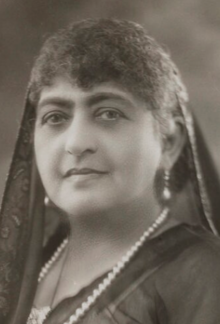Dhunbai Cowasji Jehangir
Dhunbai Cowasji Jehangir | |
|---|---|
 Dhunbai Cowasji Jehangir, from a portrait by Bassano Ltd, published with her front-page obituary in The Bombay Chronicle in 1940 | |
| Born | Dhunbai Ardeshir Wadia 1860 Bombay |
| Died | 15 July 1940 |
| Occupation | Philanthropist |
| Spouse | Jehangir Cowasji Jehangir Readymoney |
| Children | Sir Cowasji Jehangir, 2nd Baronet |
| Relatives | Jehangir Sabavala (grandson), Wadia family |
Dhunbai Cowasji Jehangir (1860 – 15 July 1940) was an Indian philanthropist and leader of women's organizations, based in Bombay.
Early life
[edit]Dhunbai Wadia was born in Bombay, the daughter of Ardeshir Hormusjee Wadia, a member of the Wadia family. Her family were Parsis.[1][2] She was presented to Queen Victoria in 1885, on her first visit to England.[3]
Career
[edit]Jehangir was a co-founder and secretary of the Princess Mary Victoria Gymkhana, a women's social and educational club in Bombay. In 1907, she presided over the All-India Women's Conference at Ahmedabad. She was vice-president of the Bombay chapter of the Indian Women's Council for many years.[3] As a leader of the Bombay branch of the National Baby and Health Week Association in the 1920s, she founded Bombay Baby Week, a week of lectures, demonstrations, and films on child health topics.[4] She represented India in 1924, at the Wembley Empire Exhibition in London. In 1927, she was one of the first women Justices of the Peace in Bombay. She received the gold Kaisar-i-Hind Medal.[1] In 1935 she was president of the Women's Branch of the Indian National Association.[5] She raised funds for women's health, famine relief, and other causes.[3] "There was hardly a movement intended to secure the educational and social progress of women with which the late Dowager Lady Cowasji Jehangir was not actively associated," noted one tribute in 1940.[6]
The Lady Dhunbai Jehangir Home for the Destitute opened in 1938.[7] It was the largest private institution of its kind in Bombay in the 1950s and 1960s.[8][9]
Personal life and legacy
[edit]In 1876, Dhunbai Wadia married banker and industrialist Jehangir Cowasji Jehangir Readymoney.[1] They had three children, all born before 1880, including two daughters, Cooverbai (who died as a young woman) and Bapsey Sabavala, and their son Sir Cowasji Jehangir, 2nd Baronet. Her husband died in 1934, and she died in 1940, aged 79 years.[3] Her Zoroastrian funeral was attended by thousands of mourners.[10]
The Sorabji Ratanji Patel Agiary in Pune includes a hall named for Lady Dhunbai Cowasjee Jehangir.[11] A portrait of Lady Jehangir is prominent at the entrance of the Cowasji Jehangir Hall in Mumbai.[12]
One of Jehangir's grandchildren was the artist Jehangir Sabavala.[13][14]
References
[edit]- ^ a b c Kabadi Waman P. (1937). Indian Whos Who 1937-38. pp. 181–182 – via Newspapers.com.
- ^ Relia, Anil (4 December 2018). The Indian Portrait - 9: A Parsi delight - Paintings, Photographs, Prints & Collectibles. Archer Art Gallery. pp. figure 119. ISBN 978-81-931718-2-0.
- ^ a b c d "Bombay Loses a Pioneer". The Bombay Chronicle. 16 July 1940. p. 1. Retrieved 27 November 2021 – via Internet Archive.
- ^ Narayanswamy, Shruti (2021). "Sanitizing Cinema: Women at Work in 1920s Bombay". Film History. 33 (1): 122–123. doi:10.2979/filmhistory.33.1.04. JSTOR 10.2979/filmhistory.33.1.04. S2CID 234772329.
- ^ "Under the auspices of the Women's Branch". The Bombay Chronicle. 26 February 1935. p. 7. Retrieved 27 November 2021 – via Internet Archive.
- ^ "A Pioneer". The Bombay Chronicle. 17 July 1940. p. 6. Retrieved 27 November 2021 – via Internet Archive.
- ^ "Problem of Helpless Beggars in City". The Bombay Chronicle. 31 March 1938. p. 10. Retrieved 27 November 2021 – via Internet Archive.
- ^ Maharashtra. India. Bombay. Home Department (1956). Annual Administration Report on the Working of the Bombay Bggars Act, 1945; for the year 1955-56. Government of Bombay (Poona). pp. 8–9, 13–14 – via Internet Archive.
- ^ Bombay Prevention of Begging Act (1964). Annual Administration Report, 1960-61: The Working of the Bombay Prevention of Begging Act. Government of Maharashtra (Bombay). p. 12 – via Internet Archive.
- ^ "Late Dowager Lady Cowasji Jehangir". The Bombay Chronicle. 17 July 1940. p. 7. Retrieved 27 November 2021 – via Internet Archive.
- ^ Kabra, Harsh (4 August 2009). "Temple of subdued grandeur". The Times of India. Archived from the original on 7 November 2015. Retrieved 27 November 2021.
- ^ Mehotra, Rahul (2002). "An Art Centre in the City the Landmark Gallery" (PDF). Jehangir Art Gallery. Retrieved 23 June 2022.
- ^ Devidayal, Namita (3 September 2011). "Jehangir Sabavala: A painter & gentleman bows out". The Times of India. Archived from the original on 3 September 2011. Retrieved 27 November 2021.
- ^ Hoskote, Ranjit; Sabavala, Jehangir (2005). The Crucible of Painting: The Art of Jehangir Sabavala. Eminence Designs Pvt. Limited. p. 42. ISBN 978-81-902170-9-5.
External links
[edit]- Dhunbai (née Wadia), Lady Jehangir, is the subject of two portraits in the collection of the National Portrait Gallery
